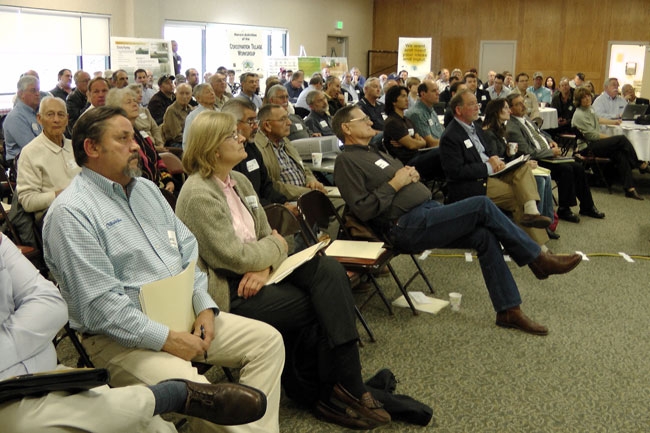Inspiration and information necessary for conservation agriculture success
The UC Conservation Agriculture Systems Initiative challenges Californians to look 100 years, or even 500 years, into the future and imagine how today’s common agricultural practices will have impacted the environment and society.
The United Nations estimates world population in 2300 will be about 9 billion. There is likely to be significant development in the ensuing 300 years that reduces the amount of land for farming.
“We have to be able to do more with less,” said Jeff Mitchell, UC Cooperative Extension cropping systems specialist, echoing a common theme repeated by speakers at the launch of the UC Conservation Agriculture Systems Initiative (CASI) Jan. 27. “The global demand for food will be immense.”
An overflow crowd of 125 farmers, equipment providers, public agency representatives and long-time conservation agriculture supporters participated in the launch. The meeting provided information about the evolution of the Institute, its recent research and development work on conservation agriculture systems, and its new capacity-building initiatives to increase the adoption of competitive and sustainable production systems in California’s San Joaquin Valley.
Mitchell, other researchers and many innovative farmers have documented in more than 14 years of field research that changes in traditional farming practices – employing such technologies as precision irrigation, integrated pest management and conservation tillage – cut costs $75 to $150 per acre, reduce dust and diesel fuel emissions 60 to 80 percent, and prevent evaporation of about 4 inches of water per season from the soil surface.
This sort of objective data, plus favorable economic analyses and access to high-technology conservation equipment, are important factors in motivating farmers to change their practices, but they are not the only factors, Mitchell said. The Institute is committed to not only demonstrating and communicating the documented benefits of conservation agriculture but also identifying the drivers behind behavior change. The goal is converting 50 percent of California crop acreage to conservation practices by 2028.
“The cornerstone of sustainability is behavior change,” said Ron Harben of the California Association of Resource Conservation Districts, one of the Initiative’s founders. “Simply providing information has little or no effect on what people do.”
In parts of the U.S. and the world, conservation agriculture is common practice. World leaders in conservation agriculture include Brazil, Argentina and Paraguay, Western Australia and Canada. Within the next ten years, Mitchell reported, more than 85 percent of the cropland in the three South American countries is expected to be converted to conservation agriculture. Adoption rates are also quite high in parts of South Dakota, Nebraska, the Pacific Northwest, and areas throughout Alabama and Georgia. Yet implementation in California is still low.
In 2010, conservation tillage systems accounted for about 14 percent of the acreage in silage and grain corn, small grains for hay, silage and grain, tomatoes, cotton, dry beans, and melons in the nine-county Central Valley region. This was an increase from about 10 percent in 2008. Minimum tillage practices were used on about 33 percent of crop acreage in 2010, up from about 21 percent in 2008.
Mitchell said the implementation trends around the world, in the U.S. and in California “lend a certain inevitability” to its wide adoption in the San Joaquin Valley.
“This is not just about making a profit and optimizing yields,” Mitchell said. “By minimizing soil disturbance, preserving surface residue and including a greater diversity of crops in the rotation we are improving the soil resources and deepening the soil in an improved condition.”
The keynote speaker at the CASI launch was Hanford dairy farmer Dino Giacomazzi, a long-time innovator in conservation agriculture. Giacomazzi discovered conservation agriculture not long after taking over day-to-day operations of the Giacomazzi dairy from his father.
“It’s less work for more money,” Giacomazzi said. “Why aren’t people doing it? What’s the holdup?”
Perhaps in answer to his own question, Giacomazzi shared the reaction of his father to the new system being used on their farm. In their last conversation, the elder Giacomazzi lamented that, “Everything I’ve ever done, you’ve undone,” his son related at the meeting.
Dino Giacomazzi said many farmers’ tendency to be “enthralled” with tradition, their fierce independence, aversion to risk and fear of derision from neighbors contribute to their resistance to change. But accepting change is what is needed to adapt to a rapidly changing world.
Giacomazzi said the new Institute will play an important role in supporting farmers as they convert to conservation practices.
“This can’t be just a launch,” Giacomazzi said. “We must make this happen. Stay in touch.”
A video of the complete CASI January 27 launch meeting will soon be available at the Institute’s website http://ucanr.org/CASI.

